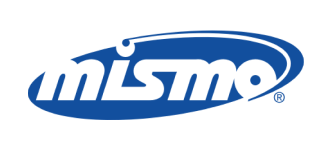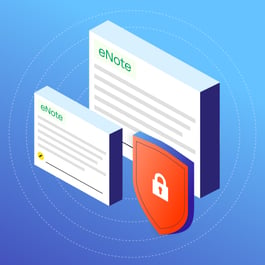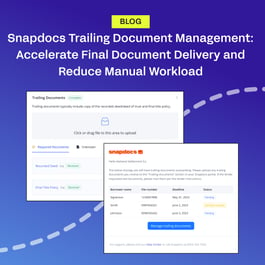Introduction
State acceptance of digital mortgage closings is complex and can make it hard for lenders to feel comfortable with the change to eClose. Navigating the variety of federal, state, and local laws and regulations governing digital closings is time-consuming and confusing. Yet, it’s critical for lenders to understand where they can execute digital closings in order to remain compliant.
In this post, we break down the complexities of state acceptance and lay out the steps for determining which states allow hybrid closings and eClosings in. By first laying out the components that are needed for digital closings and then understanding where each of those components are accepted, lenders can successfully and easily unravel the complexities of state acceptance.
What are the components of hybrid closings?
In a hybrid closing, some of the documents are electronically signed (eSigned) and some are wet signed (with a physical pen and paper). The borrower can either eSign documents before or during the closing appointment. Usually, lender or investor preferences dictate which documents are eSigned.
Because hybrid closings are any combination of eSigned and wet-signed documents, there are a variety of hybrid closings. Before determining if a state accepts digital closings, it’s important to know the types of hybrid closings.
All hybrid closings generally include eSigning. From there, lenders can add on an electronic note (eNote), electronic notarization (eNotarization), or electronic recording (eRecording). There are three common types of hybrid closings:
- A hybrid closing that includes eSigning, a paper note, and ink notarization
- A hybrid closing that includes eSigning, an eNote, and ink notarization
- A hybrid closing that includes eSigning, a paper note, and eNotarization
What are the components of eClosings?
In an eClosing, the entire closing process is digitized and all documents are eSigned and eNotarized, including the Note or if digital, called eNote. Once the closing is completed, the documents are eRecorded.
With hybrid closings, you can pick and choose what digital components you want. However, eClosings have to include eSigning, eNote, eNotarization, and eRecording. If any of those steps are not digital, the workflow no longer considered an eClosing.
Which states accept which digital closing components?
To determine if a state accepts digital closings, it’s important to first look at the acceptance of each digital closing component: eSigning, eNote, eNotarization, and eRecording.
eSigning
eSigning is valid in all 50 states because of two acts: Uniform Electronic Transactions Act (UETA) and the Electronic Signatures in Global and National Commerce (ESIGN) Act.
UETA was published by the Uniform Law Commission (ULC) in 1999, and it granted eSignatures the same legal effect as ink signatures. The act was adopted by 48 states, D.C., Puerto Rico, and the Virgin Islands. The two (2) non-adopting states–Illinois and New York–passed similar legislation that gave eSignatures the same legal weight.
However, since UETA was adopted at the state level, states could have competing laws that would complicate interstate recognition of electronic signatures. The ESIGN Act fixed that when it was signed into law in 2000. This federal act recognized eSignatures as legally valid nationally and internationally, as long as everyone consents to eSigning.
Because of UETA and ESIGN, eSigning is legally valid nationwide. Lenders can conduct hybrid closings where eSigning is the only digital component in every state.
eNotes
It’s a common misconception that eNotes aren’t legally valid. Because eNotes are eSigned, they are legal in all 50 states due to UETA and the ESIGN Act explained above. The CFPB also clearly states that “the law is clear under ESIGN and UETA: eNotes can be originated, validated, and enforced on a nationwide basis, assuming all stakeholders follow the legal requirements.” While the CFPB published this article in 2014, it is still valid today.
Remember, the promissory note is not notarized or recorded. As a result, when implementing eNotes, you don’t need to look at the state and local jurisdiction guidelines that govern eNotarization and eRecording.
Lenders can conduct hybrid closings with eSigning, eNotes, and ink notarization in every state.
eNotarization
Notaries are governed by the state, meaning eNotarize has to be enabled by each state.
Before determining whether a state allows eNotarization, it’s important to understand the types of eNotarization. There are two types: in-person electronic notarization (IPEN) and remote online notarization (RON).
Some states have passed legislation that enables both IPEN and RON, while others may have enacted only one type of eNotarization to date. If a state has not authorized RON, the state may still allow lenders to conduct RON transactions in those states. Due to interstate recognition, some states may allow an out-of-state notary who is certified to do RON in their state to conduct a remote closing.
Due to the challenges posed by COVID-19 pandemic, two senators introduced the “Securing and Enabling Commerce Using Remote and Electronic (SECURE) Notarization Act of 2020.” The SECURE Act would enable RON nationwide. However, the act has not passed.
In addition to looking at state legislation, it’s critical to also consider the recording guidelines of counties and townships. Not all jurisdictions will accept eNotarized documents. Plus, eRecording technology is required in order to record eNotarized documents, unless the state allows for papering out.
To determine the states that allow digital closings involving eNotarization, lenders must look at the eNotarization laws of every state that they do business in, as well as which jurisdictions support eRecording and accept eNotarized documents.
eRecording
In order to record eNotarized documents, jurisdictions must support eRecording. This involves having eRecording technology, training staff on how to eRecord, and informing document submitters of the new process.
Because of the cost and changes required to implement eRecording, only 55% of jurisdictions offer eRecording. However, more than 86% of Americans live in eRecording jurisdictions.
If a jurisdiction doesn’t support eRecording, eNotarized documents may still be accepted. Some states have adopted legislation for papering out, which would enable the jurisdictions in those states to record eNotarized documents without eRecording technology.
Papering out involves printing a copy of the original electronically notarized documents. The notary who performed the eNotarization certifies that the printed document is an authentic, true copy of the original electronic document. Then, the paper document and certification are submitted for recording. The papering out process differs from state to state, so it’s important to check each state’s rules to determine what’s required for papering out.
While papering out offers borrowers a completely digital closing experience in jurisdictions that don’t support eRecording, it does introduce paper into the process. This means the transaction won’t be a full eClosing.
To find out if eRecording is accepted, check if the jurisdiction where the property is located supports eRecording. Lenders can also consult settlement partners for help with visibility into the recording status of each jurisdiction.
The bottom line: look at the components
To know whether a state accepts digital closings, look at the individual digital closing components: eSigning, eNotes, eNotarization, and eRecording. There are no state laws governing digital mortgage closings; rather, states and local jurisdictions set policies for the individual parts that make up a digital closing.
States and counties have differing levels of acceptance for each digital closing part. For example, a state might allow RON, but a jurisdiction within that state may not accept remotely notarized documents or even support eRecording. A state might allow IPEN, but not RON. By looking at every component individually, you can then figure out what types of hybrid closings and eClosings can be executed in the states that you conduct business in.
Hybrid closings, in particular, take many different forms, so the type depends on which parts of the closing the lender wants to digitize. Some might think that hybrid closings aren’t allowed in a state just because the state doesn’t allow one digital component. However, if the lender does not want to digitize that component, they could be missing out on the benefits of digital closing needlessly.
Once the desired digital components are identified, look at state or county acceptance of them. If the states or jurisdictions support all the parts of a mortgage closing that is wanting to get digitized, then hybrid closings or eClosings in those locations is allowed.
Consider other closing stakeholders
Keep in mind that state acceptance doesn’t guarantee digital closings. There are many other stakeholders in the mortgage closing who lenders have to account for, like investors, warehouse lenders, and title underwriters. Those stakeholders also have to support all or some of the digital closing components that make up a hybrid closing or eClosing in order for you to do digital closings.
There are many misconceptions about digital closings, and they could be keeping lenders from gaining the benefits of digital closings, like saving time by reducing manual tasks, increasing the loan capacity of closers, and improving the borrower experience.
Wondering about other digital closing misconceptions? Read our white paper on five common digital closing misconceptions that lenders have to find out.


















